
* The Martin B-26 Marauder was one of the major American medium bombers of World War II, serving with distinction in all major battle theaters. However, in its early days the Marauder acquired a reputation as a "widow maker" that it never managed to quite live down. This document provides a history of the Martin Marauder, as well as its predecessors, the Martin B-10, Maryland, and Baltimore. A list of illustration credits is included at the end.
* In 1929, the US Army Air Corps (USAAC) issued a request for a new bomber, and the Glenn L. Martin company developed a bomber prototype for the competition with company funds. The prototype was designated the "Martin 123" and was first flown in early 1932. The USAAC evaluated the Martin bomber under the designation of "XB-907A", and after a number of changes and refinements a contract for 48 of the aircraft was issued in early 1933. The contract included:
The B-10 / B-12 went into USAAC service in 1934, and proved so satisfactory that Martin received a follow-on order for 103 definitive "B-10Bs" with uprated Wright Cyclone engines.
The B-10B was a mid-wing, all-metal monoplane with a deep-bellied fuselage that could carry a bombload of about a tonne (2,200 pounds) at about 340 KPH (210 MPH) over about 2,000 kilometers (1,250 miles). Defensive armament consisted of three 7.62-millimeter (0.30-caliber) Browning machine guns, with one firing from the belly of the aircraft, another firing from a dorsal "greenhouse" position, and the third firing from a peculiar nose position that looked like a glassed-in beehive, sitting back from the aircraft's jutting chin. The B-10B was powered by two Wright R-1820-33 Cyclones with 578 kW (775 HP) each.
___________________________________________________________________
MARTIN B-10B:
___________________________________________________________________
wingspan:
21.49 meters (70 feet 6 inches)
wing area:
62 sq_meters (678 sq_feet)
length:
13.64 meters (44 feet 9 inches)
height:
4.70 meters (15 feet 5 inches)
empty weight:
4,391 kilograms (9,681 pounds)
MTO weight:
7,439 kilograms (16,400 pounds)
max speed at altitude:
343 KPH (213 MPH / 185 KT)
service ceiling:
24,200 meters (7,375 feet)
range:
1,995 kilometers (1,240 MI / 1,080 NMI)
___________________________________________________________________
For simplicity, all the many variants of the B-10 and B-12 are collectively referred to as "B-10s" below.
* The USAAC used the B-10 to evaluate precision bombing tactics with the new Norden bombsight. A few B-10s were fitted with floats and operated as coastal-patrol aircraft. However, aircraft design was moving rapidly at the time, and beginning in 1936 the obsolescent B-10 was gradually retired to second-line roles such as target towing or training. 119 of the total of 151 B-10 bombers obtained by the USAAC were still flying in such second-line roles in 1940, when they were finally removed from service.
Martin sold an export variant of the B-10 as the "Model 139", and also developed an improved export variant, the "Model 166". The Model 166 featured refined aerodynamics, a single absurdly long greenhouse instead of the separate cockpit and gun greenhouses of other B-10 versions, and uprated Wright Cyclone engines.
Martin sold a total of 189 Model 139s and Model 166s. The USSR was the first customer, buying a single example along with plans in 1936, though the Soviet Union did not actually go on to manufacture the type. The Dutch bought a total of 120 for use in the Netherlands East Indies (now Indonesia). Other buyers were China, Siam, Argentina, and Turkey.
The Chinese are said to have actually used a few of their B-10s on leaflet "raids" against Japan in 1938. The Siamese used their B-10s against both the Japanese and, after the country was occupied by the Japanese, the French, while the Dutch used their B-10s in the hopeless defense of the Netherlands East Indies in early 1942. One Dutch Model 166 escaped to Australia with fourteen Dutch personnel on board, and was impressed as a hack into US Army Air Forces (USAAF, which superseded the Air Corps in June 1941) under the name "Miss Latrine of 1930", clearly reflecting the regard in which it was held.
The Siamese and Turks flew their B-10s into the late 1940s, and the Argentines kept theirs flying even longer. One of the Argentine aircraft is now at the US Air Force Museum at Wright-Patterson Air Force Base in Ohio, and is believed to be the only surviving B-10.
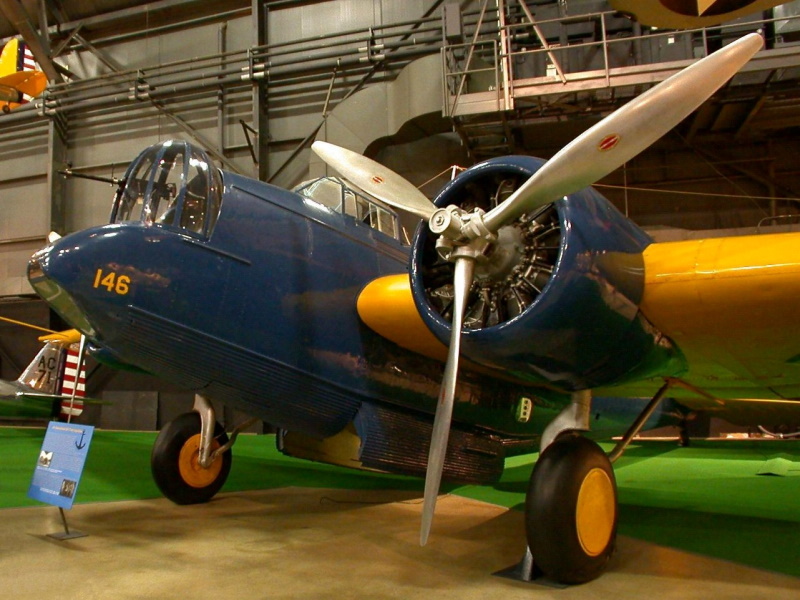
The B-10 looks laughably antiquated by modern standards -- but to be fair, it really was an aircraft of the early 1930s and was a remarkable innovation in its time. When it first flew, it was as fast as contemporary fighters, and in fact, Glenn Martin received the Collier Trophy for the design. Its problem was that aircraft design was evolving at a fast clip at the time, quickly leaving it behind the times.
BACK_TO_TOPIn 1939, the USAAC conducted a competition for a new twin-engine medium bomber, with Boeing-Stimson entering the "X-100", Douglas the "DB-7", North American the "NA-40", and Martin the "Model 167". The Martin 167 had been designed by James McDonnell, just before he left Martin in 1938 to form his own company. The Martin 167, or "XA-22" as the USAAC called it, first flew in March 1939.
Both the NA-40 and the DB-7 crashed during evaluation, leaving the Martin 167 technically the winner, but the USAAC was unimpressed with the Martin entry and awarded the contract to Douglas, the DB-7 entering service as the "A-20". North American would rethink the NA-40 for a follow-on competition, resulting in the famous "B-25". Glenn Martin, not noted for good humor, was infuriated over the rejection. To add further insult, the British Purchasing Commission examined the Martin 167 and also rejected it.
The aircraft still found a buyer. Although the Martin 167 was clearly an unimpressive aircraft, the French were desperate for new warplanes and ordered 215 Model 167s with some specified improvements. 165 of these were delivered before the fall of France in the spring of 1940. Some of these aircraft ended up in British hands. The British agreed to buy the remaining 50 on the order, these machines being designated "Maryland Mark I", and took up an option for 150 more with uprated engines, designated "Maryland Mark II". The name "Maryland" was assigned because that was where the Martin plant was located.
The Maryland Mark II was a light bomber, roughly comparable to the German Dornier Do 17 "Flying Pencil". The Maryland was a slender mid-wing monoplane, powered by two P&W R-1830-S3C4-G Twin Wasps with 895 kW (1,200 HP) each. The Maryland could carry a modest 900 kilograms (1 ton) of bombs. Defensive armament included six 7.7-millimeter (0.303-caliber) guns, with four fixed forward-firing guns in the wings, one in a flexible belly position, and one in a semi-retractable dorsal turret.
___________________________________________________________________
MARTIN MARYLAND MARK II:
___________________________________________________________________
wingspan:
18.69 meters (61 feet 4 inches)
wing area:
50 sq_meters (538.5 sq_feet)
length:
14.22 meters (46 feet 8 inches)
height:
4.57 meters (15 feet)
empty weight:
5,086 kilograms (11,213 pounds)
MTO weight:
7,624 kilograms (16,809 pounds)
max speed at altitude:
447 KPH (278 MPH / 242 KT)
service ceiling:
7,925 meters (26,000 feet)
range, max load:
1,738 kilometers (1,080 MI / 939 NMI)
___________________________________________________________________
The Marylands were flown by the British Royal Air Force (RAF) in the African and Mediterranean theaters during 1941:1942, replacing the pathetic Bristol Blenheim. They appear to have been unspectacular but rugged and reliable, giving useful service in the bomber, reconnaissance, and even fighter roles -- flying from Malta to intercept German transports trying to resupply Rommel's Afrika Corps.
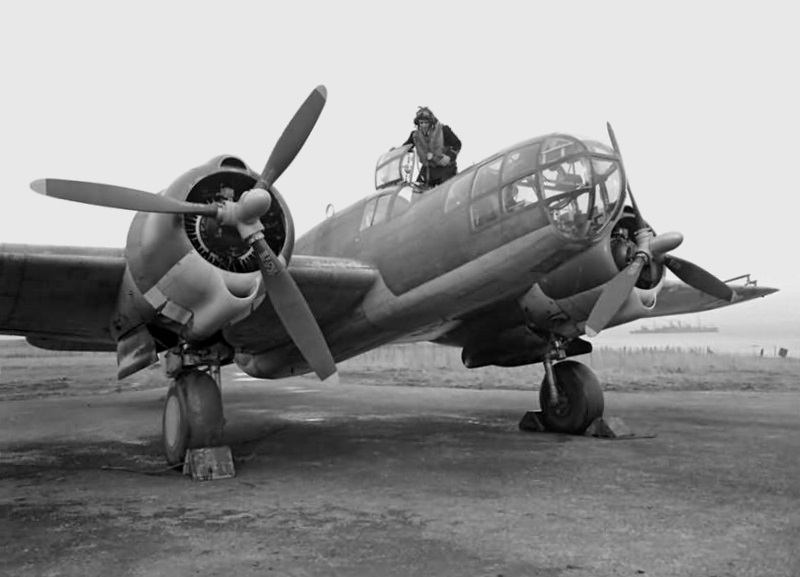
A number of Marylands were also passed from the RAF to the South African Air Force (SAAF), and three were operated by the British Royal Navy's Fleet Air Arm (FAA), it seems as scouts. On 22 May 1941, one FAA Maryland spotted the German battleship BISMARCK putting out to sea, starting one of the greatest naval pursuits in history.
* Despite the fact that the British had put the Maryland to good use, it was still no prize-winner, being somewhat slow and clearly lacking in firepower, and in fact Martin had been working with the French to come up with a more formidable derivative, the "Martin 187".
This new aircraft had the Maryland's wing but a deeper fuselage that allowed the crew to move between the front and back compartments, and more powerful Wright GR-2600-A5B5 Double Cyclones with 1,238 kW (1,660 HP) each. Defensive armament and bombload were initially the same as that of the Maryland, but there was room for improvement. The French signed a letter of intent to buy 400 Martin 187s in May 1940, but the immediate military collapse of the French left that deal in limbo. The British quickly took over the contract and specified minor changes in equipment fit to meet their needs.
The first Model 187 flew on 14 June 1941. The first 50 of the order were flown to Britain, where they were designated "Baltimore Mark I", since the Martin plant was near the city of Baltimore. They were followed by 100 "Baltimore Mark IIs", which had twin Vickers 7.7-millimeter machine guns in the dorsal position instead of a single gun, and then by 250 "Baltimore Mark IIIs" with a Boulton-Paul turret with twin 7.7-millimeter guns in the dorsal position.
Like the Maryland, the Baltimore Mark III could carry 900 kilograms (1 ton) of bombs. Gun armament consisted of eight 7.7-millimeter guns, with four fixed guns in the wings, two in the dorsal turret, and two in a flexible belly position. Four fixed rearward-firing 7.7-millimeter guns were also sometimes fitted for strafing.
That finished off the initial order, but following America's passage of the Lend-Lease Act in March 1941, the US government funded more Baltimores for Britain, beginning with 281 "Baltimore Mark IIIAs", which were generally similar to the Mark III. They were followed by 294 "Baltimore Mark IVs", with a Martin dorsal turret instead of the Boulton-Paul turret and uprated engines, and finally 600 "Baltimore Mark Vs", which were generally similar to the Mark IVs. Some sources claim the Mark V was fitted with 12.7-millimeter (0.50-caliber) guns instead of standard British 7.7-millimeter guns.
___________________________________________________________________
MARTIN BALTIMORE MARK IV:
___________________________________________________________________
wingspan:
18.61 meters (61 feet 4 inches)
wing area:
50.03 sq_meters (538.5 sq_feet)
length:
14.80 meters (48 feet 6 inches)
height:
5.41 meters (17 feet 9 inches)
empty weight:
7,013 kilograms (15,460 pounds)
MTO weight:
10,251 kilograms (22,600 pounds)
max speed at altitude:
491 KPH (305 MPH / 265 KT)
service ceiling:
7,100 meters (23,300 feet)
range:
1,741 kilometers (1,082 MI / 941 NMI)
___________________________________________________________________
The last Baltimores were rolled out in May 1944. A "Baltimore Mark VI" was considered for the RAF Coastal Command, but none were built. A small number of Baltimores funded under Lend-Lease were retained by the USAAF for evaluation under the designation "A-30", but the type never saw combat service with the USAAF.
The Baltimore served with the RAF and the Royal Australian Air Force in the African and Mediterranean theaters up to the end of the war, seeing heavy action in Italy. They were flown by the RAF in Kenya until early 1946, when they were retired from service.
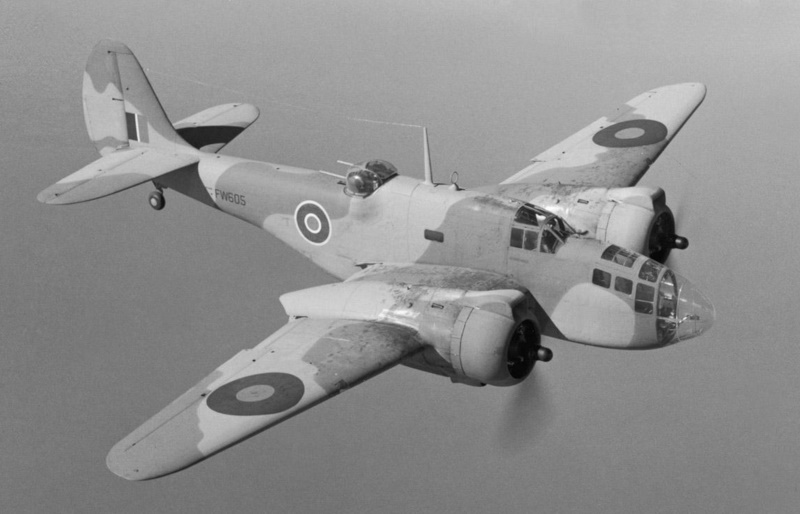
The Baltimore was a reasonably combat-worthy aircraft, with some similarities in appearance and capability to the Douglas A-20 Boston. In fact, the two aircraft had almost the same general dimensions and the same engines, though the Baltimore had a higher empty weight; performance of the two aircraft was similar. Some sources claim that the Baltimore had poorer handling characteristics than the Boston, while others claim it handled well.
BACK_TO_TOP* Even as Martin was updating the Maryland to create the Baltimore, the company was coming up with a much more advanced and capable design, in fact one that would prove a little too advanced in some respects.
In the late 1930s, the USAAC's first line medium bombers were the B-10 and the Douglas B-18 Bolo, both of which were clearly obsolescent and not up to a modern combat environment. The Air Corps issued a request for a new medium bomber in January 1939, specifying a top speed of 520 KPH (320 MPH), a range of 2,900 kilometers (1,800 miles), and a loaded weight of 12,080 kilograms (26,625 pounds). These were aggressive requirements, and in addition the USAAC also specified that the aircraft have adequate armament for self-defense, crew armor, and self-sealing tanks.
Martin responded with the "Martin 179", designed by a team under a young engineer named Peyton M. Magruder, with the proposal submitted in July 1939. The USAAC was impressed and quickly awarded Martin a contract for 201 "B-26s", as the Air Corps designated the aircraft. This was remarkable since no prototype had been flown, and for that matter no prototype was even formally planned. Martin's reputation with the USAAC was good, and the company promised quick delivery.
The first B-26 flew on 25 November 1940 and was effectively the prototype. It is an indication of the USAAC's sense of urgency that by this date there were already orders for 1,131 B-26s on the books. Although B-26 had over twice the specified bombload, it didn't actually meet all the design specifications. Top speed was 507 KPH (315 MPH), close to specification, but range was a disappointing 1,600 kilometers (1,000 miles).
Few could fault it for looks, however. The B-26 was a beautifully streamlined aircraft of all-metal construction, except for a fabric-covered rudder, with a fuselage featuring a circular cross-section; a high wing; and twin P&W R-2800-5 Double Wasp engines with 1,380 kW (1,850 HP) each, and driving four-blade propellers with electrical pitch control.
The aircraft had tricycle landing gear, with the nose wheel rotating 90 degrees during retraction, plus defensive armament of one 7.62-millimeter Browning machine gun in the nose, two 12.7-millimeter Browning guns in a Martin dorsal turret, and a single flexible 7.62-millimeter Browning in the tail. The B-26 could carry two 900-kilogram (2,000-pound) bombs internally, or up to 2,180 kilograms (4,800 pounds) of smaller bombs, though in later practice the warload would almost never be greater than 1,800 kilograms (4,000 pounds). The B-26 accommodated a crew of five, though in later variants that number would grow to seven.
In order to achieve its high speed, the B-26 had relatively short wings with modest wing area. That gave it a long take-off run and a fast landing speed. Such features had been expected by the USAAC, given the aggressive performance specifications, but they would still almost be the death of the B-26.
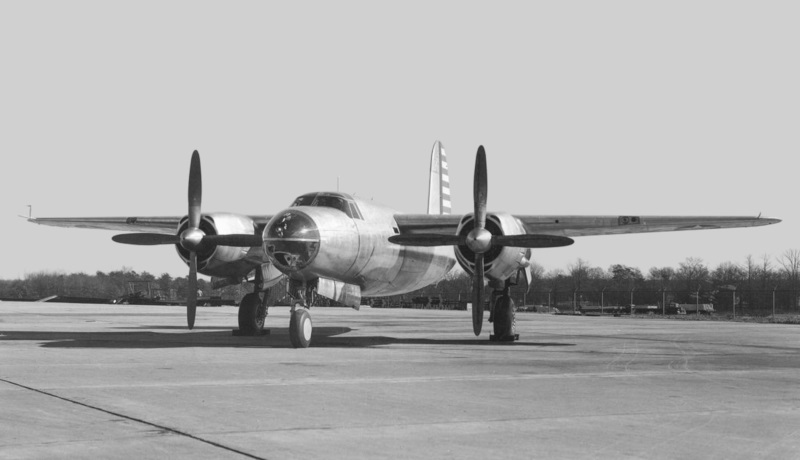
* Production deliveries of the other 200 B-26s began in February 1940. These aircraft were really used for test, operational evaluation, and operational training, processes that proved troublesome. The B-26 was a very "hot" aircraft in a number of different ways, and it was a handful for inexperienced pilots. Early deliveries also didn't have full combat fit, leaving them noseheavy and causing nosewheel strut failures.
While the USAAF was grappling with the difficulties of getting the new bomber into operation, in October 1941 Martin began delivering the next variant, the "B-26A", with 139 built. The B-26A dealt with the range issue by accommodating a removeable fuel tank in the bomb bay. The B-26A had torpedo shackles on the bomb bay doors to allow it to carry a single 900-kilogram (2,000-pound) torpedo; replaced the nose and tail 7.62-millimeter guns with 12.7-millimeter guns; and changed the electrical system from 12 to 24 volts DC.
All but the first 30 B-26As had uprated R-2800-39 engines. 52 later production B-26As were provided to the RAF, which gave them the designation of "Marauder I". Three went to the UK for evaluation, while the rest went to the Middle East. The USAAF adopted the name Marauder as well.
BACK_TO_TOP* By the end of 1941, the USAAF 22nd Bomb Group (BG) had been equipped with the Marauder, and after the Pearl Harbor attack on 7 December 1941 the 22 BG was shipped off to Australia, arriving in February 1942. These Marauders performed the type's first combat mission, a raid on the main Japanese base in the South Pacific at Rabaul on New Britain on 5 April 1942. Some of the Marauders operating in the South Pacific were fitted with an additional machine gun in the nose.
Four Marauders were used in the torpedo-bomber role at the Battle of Midway in June 1942, attacking Japanese carriers but scoring no hits and losing two of their number. Torpedo-carrying Marauders attacked the Japanese carrier RYUUJOU off the Aleutians the same day, but no hits were scored. These were the first and last times the Marauder saw combat with the USAAF as a torpedo bomber.
The pilot of one of the Marauders at Midway, Lieutenant James P. Muri, did establish a legend of sorts by flying straight up the deck of the carrier AKAGI after his torpedo run, throwing Japanese deck crew onto their faces. Muri insisted later he didn't pull this stunt out of any sense of daring, instead seeing the carrier as being the only place he could go where he might not be shot at for a moment -- but whatever the motivation, the Japanese were flabbergasted. His Marauder, SUZIE-Q, made it back to Midway, but it was so thoroughly shot full of holes that it was simply stripped of what little useful hardware was left, then shoved into the Pacific by a bulldozer.
In April 1942, production had moved on to the "B-26B", the definitive Marauder variant, though it was built in a series of production blocks with successive improvements. The initial "B-26B-1" subvariant had new engine cowlings; deleted the propeller spinners; added armor protection and a new ventral gun position with a single flexible 12.7-millimeter gun; and had a revised tailgun position with twin 12.7-millimeter tail guns in a new rear fuselage that extended the aircraft's length by 70 centimeters (28 inches).
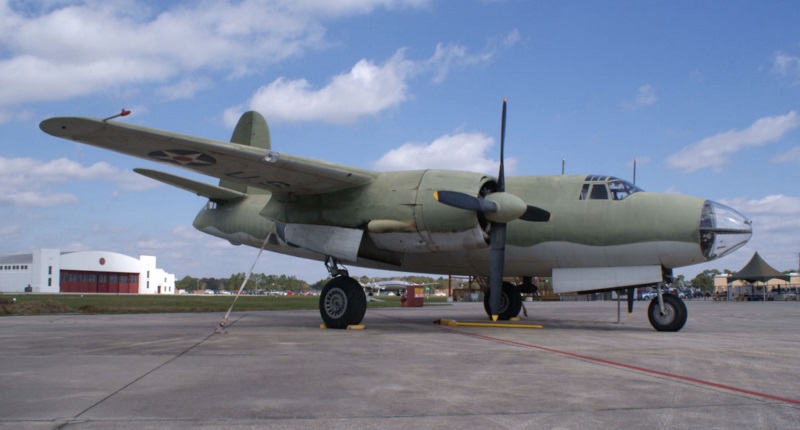
These additions increased the aircraft's weight while engine power remained the same, but later B-26B production blocks, starting with the "B-26B-2", had P&W R-2800-41 engines with 1,492 kW (2,000 HP) each. The "B-26B-3" was essentially identical to the B-26B-2, but had larger carburetor air intakes on top of the engine cowling to allow fit of sand filters for desert operations.
By this time, the Marauder's safety record had become highly controversial. There were obvious difficulties with the long take-off run, fast landing speeds, and unfamiliar tricycle landing gear configuration. Another problem was that the electrically operated propellers were prone to wiring faults, causing them to go to flat pitch and "runaway" at high RPM. The ground crews were also unused to working on an aircraft that had so many electrical systems; techs tended to run the batteries down while performing maintenance, leading to battery power failure and loss of prop pitch control on take-off.
The result was a series of deadly accidents. Flight training was conducted out of Tampa, Florida, resulting in the slogan "a Marauder a day in Tampa Bay", and the B-26 became known as "the Martin Murderer", the "Baltimore Whore" or the "Flying Prostitute" -- the last two partly because the wings were so short the aircraft was said to have no visible means of support. The real problem was that the USAAF was going into war in a great hurry with new, advanced equipment, and the service was forced to figure out how to train crews for faster aircraft as an ongoing exercise. Matters improved once the USAAF obtained twin-engine trainers, allowing cadet pilots to get twin-engine experience before moving on to the Marauder; gave ground crews battery carts; and tightened up procedures in general.
Coming up with such improved procedures took time, and meanwhile there was a public outcry over the Marauder. The type had its champions who managed to protect it. Reports from crews flying combat missions with the Marauder were enthusiastic, and the prestigious Colonel Jimmy Doolittle took a B-26A on a stateside tour to show off what it could do, often putting it through its paces after feathering an engine. Doolittle did admit that it was an unforgiving aircraft.
Martin made changes in the design in hopes of improving aircraft safety. The "B-26B-4" introduced a longer nosewheel leg to give the aircraft a steeper wing incidence to reduce take-off run, and also changed the ventral gun to one flexible 12.7-millimeter gun on each beam position. The "B-26B-5" added slotted flaps to reduce landing speed.
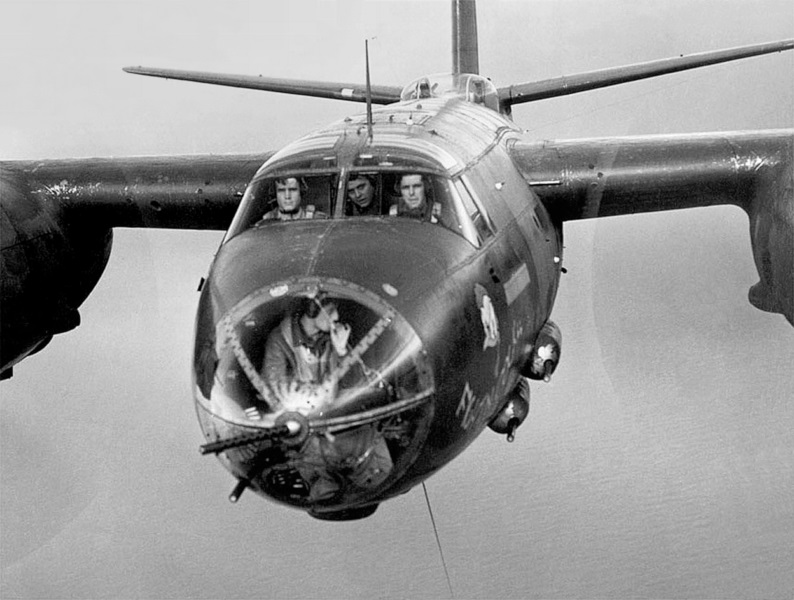
A total of 641 B-26B-1 through B-26B-5 Marauders was built, and then Martin began production of the "B-26B-10", with significant changes. The B-26B-10 featured greater wingspan in hopes of reducing the Marauder's wing loading, a new power-operated Martin-Bell tail turret with twin 12.7-millimeter guns, and four fixed forward-firing 12.7-millimeter guns for strafing, fitted in "packages" beneath the cockpit. The tailfin was increased in height and area to improve yaw stability. The engines were R-2800-43s, with mechanical improvements but no increase in horsepower over the -41 engines.
___________________________________________________________________
MARTIN B-26B-10 MARAUDER:
___________________________________________________________________
wingspan:
21.6 meters (71 feet)
wing area:
61.13 sq_meters (658 sq_feet)
length:
17.8 meters (58 feet 3 inches)
height:
6.55 meters (21 feet 6 inches)
empty weight:
10,900 kilograms (24,000 pounds)
max loaded weight:
16,800 kilograms (37,000 pounds)
maximum speed:
454 KPH (282 MPH / 245 KT)
service ceiling:
6,400 meters (21,000 feet)
range:
1,850 kilometers (1,150 MI / 1,000 NMI)
___________________________________________________________________
Unfortunately, given the aircraft's increase in weight, lengthening the wings simply amounted to "running faster to stay in the same place", and in fact the B-26B-10 had a slightly faster landing speed than its predecessors. The only thing that could be said is that without the longer wings, the aircraft would probably have been even more of a handful to deal with.
The B-26B-10 was followed by similar blocks, up to the "B-26B-55". Most of the blocks were hard to tell from the B-26B-10, but "B-26B-45" introduced a new windscreen arrangement, providing wider panels that simplified the cockpit framework and gave the pilot and copilot a better view. A total of 1,242 of these later blocks was built at Martin's Baltimore-area plant at Middle River, with 19 of these provided to the RAF as "Marauder IAs" and sent to Egypt. Total production of all subvariants of the B-26B was 1,883.
* In the meantime, Martin had also opened a factory in Omaha, Nebraska, which began producing aircraft equivalent to the B-26B-10 and later blocks under the designation "B-26C". Marauders built in Baltimore were given the designation suffix "-MA", while those built in Omaha had the suffix "-MO". For example, a B-26B-50-MA was a Baltimore-built machine. 1,210 B-26Cs were built, with 100 provided to the RAF as "Marauder IIs". The Marauder IIs were passed on to the SAAF.
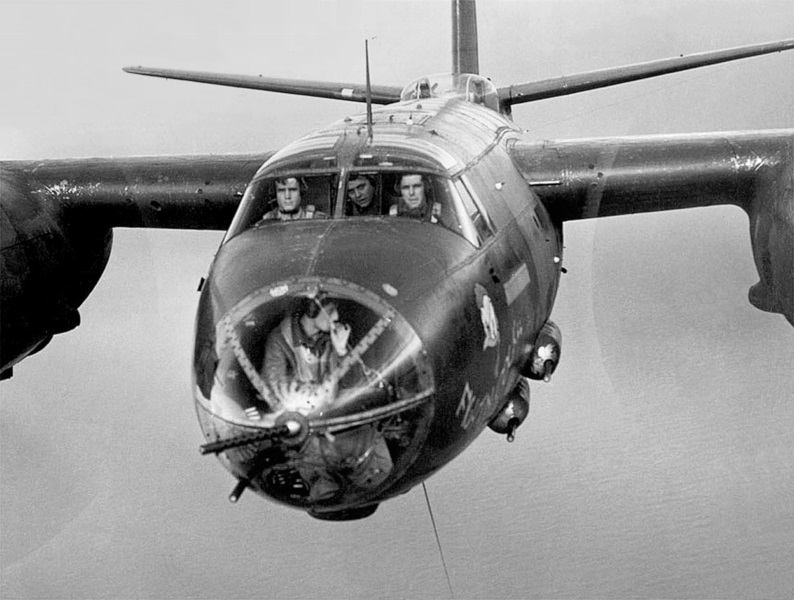
The Marauder was phased out of the Pacific theater in 1942 and 1943, being replaced by the North American B-25 Mitchell. The Mitchell was felt to be better suited to Pacific island operations since it had longer range and a shorter take-off run appropriate to small island runways. However, Marauders saw increasing use against the Germans after the Allied invasion of North Africa in late 1942, and were heavily used in combat in the Mediterranean, Italy, and over Northern Europe.
Initial B-26 operations over Northern Europe were unpromising. The Marauder's first operation in the region was on 14 May 1943 and was a partial success, but the second mission on 17 May 1943 resulted in the loss of all ten Marauders from flak, fighters, and mid-air collisions.
These initial raids were conducted at low altitude. Missions were moved to medium and high altitude with better results, but despite the Marauder's good performance and armament, the notion of unescorted bomber raids with the B-26 proved as much an illusion as it had with the B-17 and B-24 heavy bombers. It wasn't until early 1944, when long-range escorts became available, that the Marauder began to come into its own. It was heavily used in tactical support of advancing Allied armies after D-Day.
At its peak, the Marauder was operated by a dozen USAAF bomb groups, most heavily by the USAAF 9th Air Force. Strikes were performed with two 900-kilogram (2,000-pound) bombs, eight 225-kilogram (500-pound) bombs, or 16 113-kilogram (250-pound) bombs. Its combat loss rate was one of the lowest of all USAAF types. One Marauder, named "Flak Bait", survived 202 combat missions.
In early operations, USAAF Marauders were painted in standard olive drab and gray colors, but as the Allies gained air superiority, B-26s were generally left in natural metal finish. Camouflage came back in the last months of the war, however, since they were operated off forward airfields that were sometimes targeted by Luftwaffe air strikes.
The RAF had the same initial reservations about the "Martin Murderer" as the USAAF, and went through a similar learning curve before putting it to good use. Most RAF Marauders were used in North Africa and the Middle East, initially replacing Blenheims. That must have been a mixed blessing to Blenheim crews: the Blenheim was docile but suicidally vulnerable in combat, while the Marauder was unforgiving, but could take the heat and dish out punishment as well.
In North Africa, the RAF operated five squadrons of Marauders, the SAAF operated six squadrons, and the Free French operated six squadrons. It appears that the Free French generally removed two of the four "package" machine guns. The British apparently used them initially as torpedo-bombers in the Mediterranean with considerably greater success than enjoyed by the USAAF in that role. Marauders were also used for minelaying, maritime reconnaissance, and like the Maryland before it, as a fighter to intercept German transports flying to Africa. They later saw RAF and SAAF service in Italy, and in support of Tito's partisans in Yugoslavia.
BACK_TO_TOP* One of the original B-26s was converted to test a wing de-icing system driven by engine bleed air. It was designated the "XB-26D" and was strictly experimental. A "B-26E" was considered, involving a stripped-down Marauder with weight reduced by 900 kilograms (2,000 pounds) and the dorsal turret moved forward, but none were built.
That meant that the next production version was actually the "B-26F", which was put into production at the Baltimore plant in 1943, with 300 built. The B-26F was similar to early-block B-26Bs with -41 engines, but had the wing incidence shifted up by 3.5 degrees to shorten the take-off run, though at a cost of a reduced top speed; experienced Marauder crews tended to regard this "improvement" as a step backward. Provision for torpedo carriage was also removed. 200 of these aircraft were supplied to the RAF as "Marauder IIIs".
The final bomber version of the Marauder was the "B-26G", which was much like the B-26F except that it had -43 engines. 893 were built by Martin Baltimore, with 150 supplied to the RAF, retaining the designation of Marauder III.
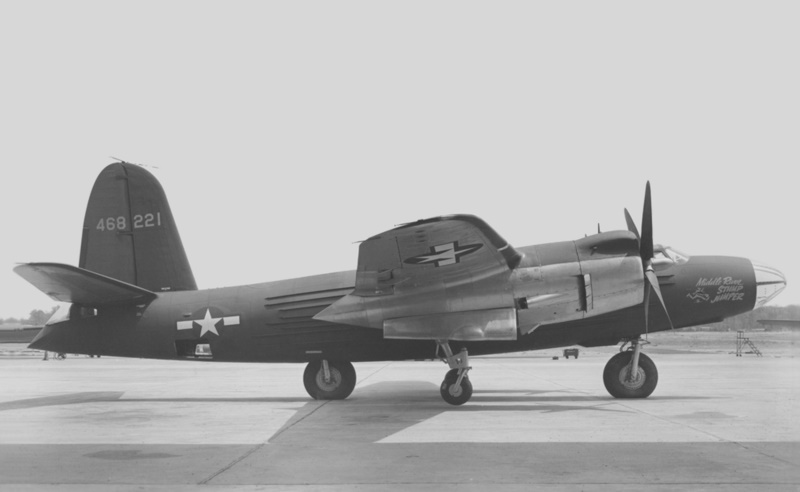
* While Martin was producing the B-26B and B-26C bomber versions of the Marauder, they also built 583 stripped-down Marauders for training and target towing duties. These aircraft had a target winch while their armor and armament was removed, presumably improving their take-off and landing performance. The "AT-23A" was equivalent to the B-26B, with 208 built in Baltimore; the "AT-23B" was equivalent to the B-26C, with 375 built in Omaha.
These machines had a somewhat convoluted history, with 225 of the AT-23Bs transferred from the USAAF to the US Navy in 1944 and 1945, and some of the Navy machines operated by the Marine Corps. The Navy gave them the new designation of "JM-1", and a few were converted to "JM-1P" photo-reconnaissance aircraft. In 1945, the USAAF redesignated their remaining AT-23A and AT-23B Marauders to "TB-26B" and "TB-26C" respectively. The USAAF trainer-tugs were left in natural metal finish, but the Navy and Marine Corps painted theirs a gaudy chrome yellow, to discourage fighter pilots from tying to engage the tug instead of the tow target.
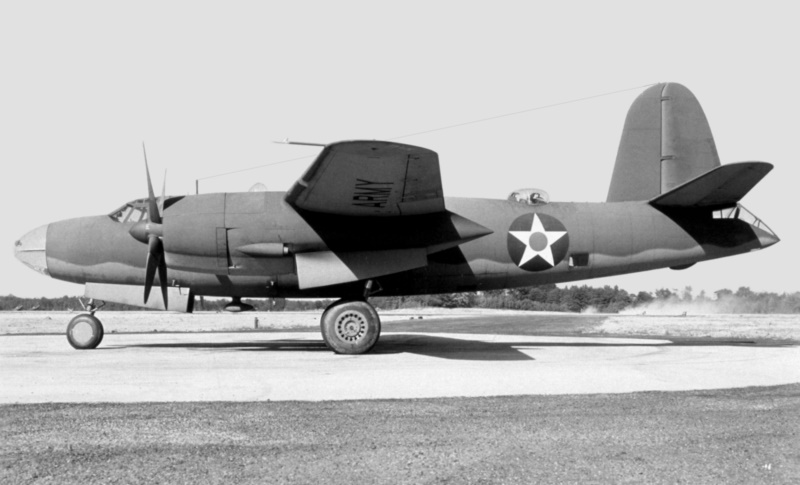
The last batch of Marauders built were 57 "TB-26Gs", which were stripped-down trainer / target tug versions of the B-26G. 47 of the TB-26Gs were transferred to the US Navy as "JM-2s". The only other Marauder variant was the single "XB-26H", named the "Middle River Stump Jumper", a test article converted from a B-26G to evaluate the "bicycle" tandem landing gear scheme for the Boeing XB-47 and Martin XB-48 bombers.
A total of 5,266 Marauders were built, with a variant list following:
* The British phased the Marauder out of service soon after the war. Lend-Lease required that they be returned to the US, but the USAAF didn't want them, and so they were scrapped. The French gave up their last B-26s in 1947, and what few Marauders that were still in the US Air Force inventory in 1948 were finally declared obsolete and phased out. The B-26 designation was then passed on to the Douglas A-26 Invader.
The Marauder had provided excellent service and had its champions, but it was and remains in the shadow of the B-25 Mitchell. Only about half as many Marauders were made as Mitchells, partly because Mitchells were cheaper by a substantial fraction, and the Mitchell never had to live down a reputation as bad as the Marauder's.
The Marauder saw little or no use in civil hands in the postwar period, and is now a very rare warbird. "Flak Bait" is on static display with the Smithsonian National Air & Space Museum in Washington DC. The US warbird collector's organization, the Commemorative Air Force, had a B-26C named "Carefree Carolyn" in flying condition that was lost in a fatal crash in 1995. The only Marauder still in flying condition is an early-model B-26 now owned by aircraft collector Kermit Weeks, salvaged in 1972 from three forced down in the wilds of Canada on a ferry flight to Alaska in 1942, and returned to flight condition in the early 1990s.
BACK_TO_TOP* A Marauder pilot named Chuck O'Mahony published his memoirs of flying the type in COMBAT AIRCRAFT magazine in 1999. He asked during flight training to be assigned to the "hottest plane" the USAAF had, and ended up at the controls of the B-26. In his article, he confirmed many of the details concerning the B-26 mentioned in other sources, but added a number of interesting personal comments.
For example, the B-26 was said to need half the state of Texas to take off and had the glide characteristics of a flatiron. Even getting in and out of the airplane was hazardous, since the entrance was behind the nosewheel and dangerously close to the spinning propellers.
During training, he was copilot during a landing when one of the B-26's propellers went into runaway. The aircraft went into a ditch, but fortunately the aircraft didn't explode into a ball of fire -- all he and the pilot got out of the accident were bruises and stitches. The base commander, a Colonel Manson, showed up to see how they were, and reassured them that the accident had been beyond their control. O'Mahony apologized for wrecking the airplane, but Manson, clearly an easy-going type, replied cheerfully: "Don't worry about it, son. That's what people buy bonds for."
As a training exercise, O'Mahony also flew a B-26 from Texas to Miami, Florida, with a stopover in Mobile, Alabama. There were soldiers and sailors hanging around at the airfield in Mobile, looking to hitch rides, and some of them were interested to find out that O'Mahony's aircraft was going on to Miami. Then a sailor asked him: "What are you flying?"
He replied: "A B-26." They all lost interest.

* I decided to add details on the B-10, the Maryland, and the Baltimore to this document because they weren't really worth discussing in detail on their own. As it turned out, I spent about as much time trying to chase down details on them as I did on the B-26.
* Sources include:
* Illustrations credits:
* Revision history:
v1.0 / 01 jul 00 / v1.1.0 / 01 may 03 / Cleanup, stats on B-10, Maryland, & Baltimore. v1.1.1 / 01 mar 05 / Review & polish. v1.1.2 / 01 feb 07 / Review & polish. v1.1.3 / 01 feb 09 / Review & polish. v1.1.4 / 01 jan 11 / Review & polish. v1.1.5 / 01 dec 12 / Review & polish. v1.1.6 / 01 nov 14 / Review & polish. v1.1.7 / 01 oct 16 / Review & polish. v1.1.8 / 01 sep 18 / Review & polish. v1.2.0 / 01 sep 20 / Illustrations update. v1.2.1 / 01 jul 22 / Review & polish. v1.2.2 / 01 jul 23 / Review & polish. v1.2.3 / 01 jun 25 / Review & polish.BACK_TO_TOP
